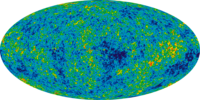Cosmic background radiation

Alright kiddo, have you ever wondered how we know things about the universe? There are no telescopes big enough to see it all! But scientists have a trick up their sleeve. They can study the light that comes to us from all around the universe, like a big puzzle.
Now imagine that you live in a big city and you want to take a picture of the stars. But you can't see anything because all the street lights are in your way. So it's hard to figure out what's out there beyond the city.
Scientists faced a similar problem. They couldn't see far beyond our galaxy because the light from other stars got in the way. But then they figured out that if they looked at the sky with a special kind of telescope that can "see" in a different way, they could pick up tiny bits of light that have traveled from the edge of the universe all the way to Earth. And that's called cosmic background radiation!
These little bits of light are everywhere, all the time, and they come from every direction. They're kind of like little clues that tell scientists what the universe was like a long, long time ago, soon after it was created.
It's like looking at a snapshot from when the universe was just starting to form. By studying the cosmic background radiation, scientists can learn things like:
- How hot the universe was when it started (spoiler alert: super hot!)
- How the very first objects in the universe formed (like the first stars and galaxies)
- What the universe is made of (like dark energy and dark matter)
And that's cosmic background radiation in a nutshell!
Now imagine that you live in a big city and you want to take a picture of the stars. But you can't see anything because all the street lights are in your way. So it's hard to figure out what's out there beyond the city.
Scientists faced a similar problem. They couldn't see far beyond our galaxy because the light from other stars got in the way. But then they figured out that if they looked at the sky with a special kind of telescope that can "see" in a different way, they could pick up tiny bits of light that have traveled from the edge of the universe all the way to Earth. And that's called cosmic background radiation!
These little bits of light are everywhere, all the time, and they come from every direction. They're kind of like little clues that tell scientists what the universe was like a long, long time ago, soon after it was created.
It's like looking at a snapshot from when the universe was just starting to form. By studying the cosmic background radiation, scientists can learn things like:
- How hot the universe was when it started (spoiler alert: super hot!)
- How the very first objects in the universe formed (like the first stars and galaxies)
- What the universe is made of (like dark energy and dark matter)
And that's cosmic background radiation in a nutshell!
Related topics others have asked about:
